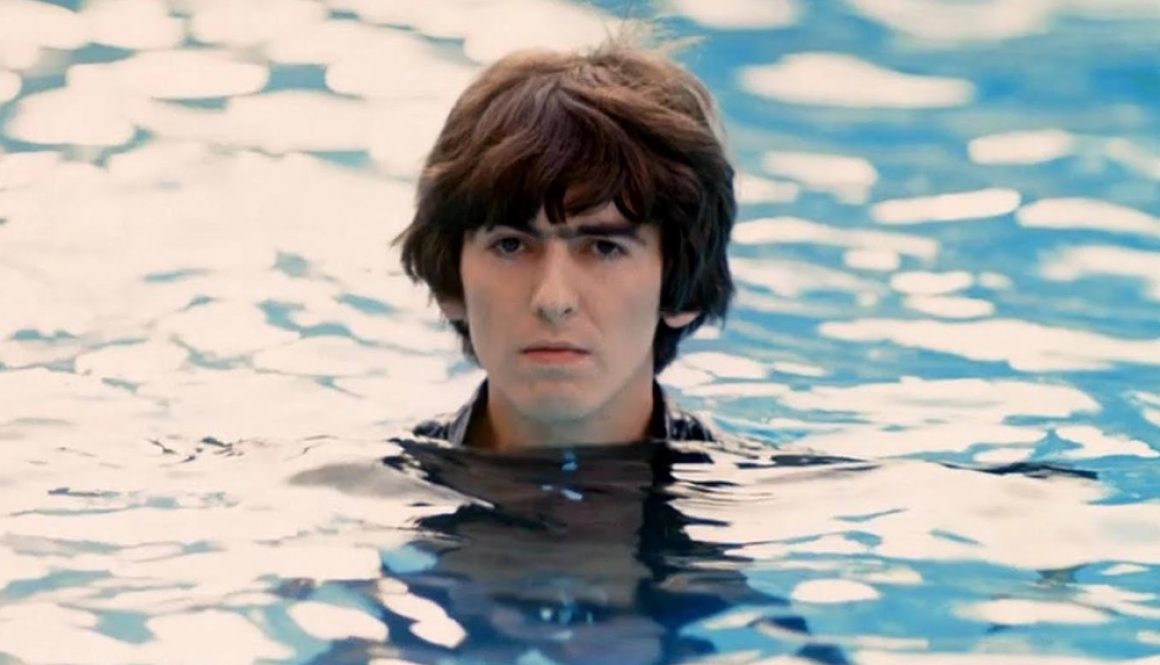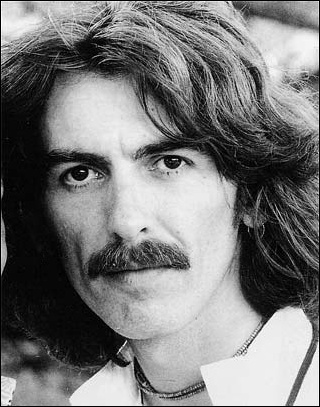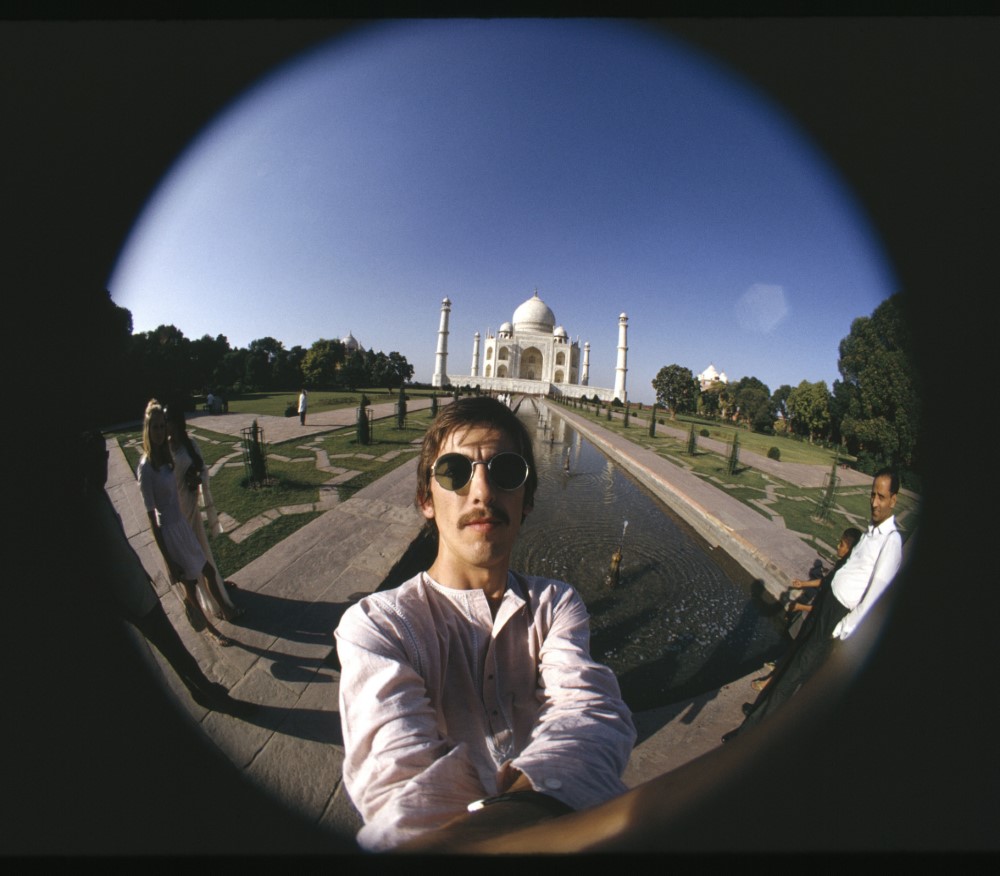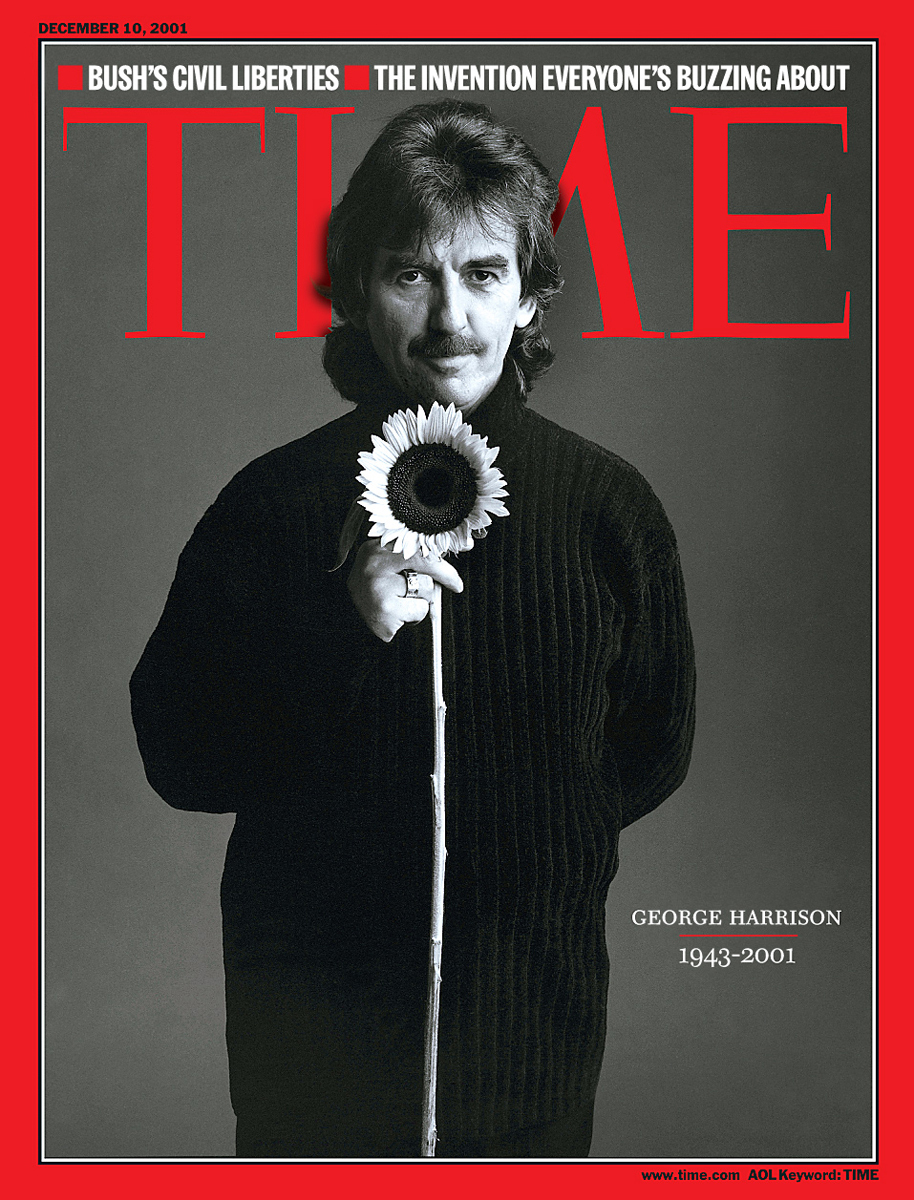George Harrison – Music Biography

“The farther one travels the less one knows” The Inner Light, The Beatles 1968, music and lyrics by George Harrison
In 1968 George Harrison traveled to Bombay to record a film score with Indian musicians playing sitar, tablas and other traditional Indian musical instruments. On his last day in the studio he recorded the music for “The Inner Light.” He returned to Abbey Road Studios in London and added lyrics inspired by the ancient philosophy of the Taoist Way. Spiritual forays such as “The Inner Light” only confirmed that George Harrison’s way was not the way of the rock star. His thoughtful and professional stage presence had already earned him the reputation of being “the quiet Beatle.” He dodged fame and celebrity life at the height of Beatlemania to immerse himself in spirituality and meditation. The paradox of George Harrison is that fame and material wealth are the things that allowed him to live a spiritual and reclusive life.
Like other members of the Beatles, George Harrison came from a working class family in Liverpool. Born just before midnight on February 24, 1943, he was the youngest of four children. He claims to have had an epiphany of sorts when he was 12 or 13 years old – while riding his bike around the neighborhood he heard Elvis Presley’s “Heartbreak Hotel” playing from a nearby house and was instantly hooked on music. He spent £3 (a lot of money in those days) on his first guitar and started devoting his time to music, practicing along to records of his early musical heroes like American rockabilly idol Carl Perkins and British skiffle legend Donnie Lonegan.
“I had no ambition when I was a kid other than to play guitar and get in a rock ‘n’ roll band. I don’t really like to be the guy in the white suit at the front.” – West 57th Street interview, December 1987
While studying at the Liverpool Institute he met an older student named Paul McCartney. Impressed by Harrison’s knowledge of more than just the basic chords, McCartney introduced him to John Lennon. Their skiffle band, The Quarrymen, needed someone to play lead guitar and the fifteen year old Harrison was invited to join. Two years later, in 1960, the band was covering rock and roll hits by Elvis Presley, Little Richard and Chuck Berry. And they’d also changed their name to The Beatles. Adding Ringo Starr to their lineup in 1962 they began a rapid succession of hit songs that soon made them the most famous rock group in the world.
Harrison’s subdued lead guitar style combined elements of rockabilly and country and helped shape the sound of mid-1960s pop music, yet his influence went well beyond the guitar, as did his own playing. His use of the twelve string guitar on A Hard Day’s Night (1964) also popularized its use by other bands, like the Byrds and, later, Tom Petty. He, along with Ray Davies of the Kinks, was one of the first pop stars to make use of sitars and Indian musical influeneces in rock music. In addition to the sitar, Harrison could also play traditional Indian instruments like the tambura, sarod and swarmandal. Brian Jones of the Rolling Stones taught himself how to play the sitar after a visit with Harrison and performed on it on “Paint It Black.” Jones was also both sitar and tamboura on “Street Fighting Man.” And when Delaney Bramlett of the band Delaney & Bonnie introduced Harrison to slide guitar in 1968, he became a leading proponent of that style as well.
“Not guilty for leading you astray, on the road to Mandalay.” Not Guilty, recorded for The White Album in 1968
George Harrison was only twenty-six when the Beatles broke up. For someone who preferred being a musician to being a rock star, he achieved tremendous amount of success outside of the Beatles. He was the first ex-Beatle to achieve a number one single “My Sweet Lord” and number one album “All Things Must Pass” in 1970. He was also the first band member to do a solo tour and the only one to ever open his own record label and film production company.
“I’ve got no time for you right now, don’t bother me.” Don’t Bother Me, the first Beatles song Harrison wrote, 1963
Listed by Rolling Stone as one of its choices of “the 100 Greatest Guitarists of All Time,” Harrison often shied away from media and publicity, at times even refusing to promote his own music. His quiet and diffident public image mirrored the first song he wrote for the Beatles: “Don’t Bother Me” from With The Beatles in 1963. The song, unusually mirthless for early Beatles, was written while Harrison was laid up sick in a hotel. Up to this point Lennon and McCartney were getting all the songwriting credit and Harrison wanted to see if he could write as well. He didn’t think it was a particularly good song but the experience showed him that if he kept writing he might eventually write something he thought was good.
“I think people who truly can live a life in music are telling the world, “You can have my love, you can have my smiles. Forget the bad parts, you don’t need them. Just take the music, the goodness, because it’s the very best, and it’s the part I give most willingly”
In 1991 Eric Clapton had to coax Harrison out of seclusion to play a tour of Japan. He hadn’t toured since 1974, even though recent years had been kind to him. The critically acclaimed Cloud Nine (1987) became his best-selling album in years, thanks to his popular reworking of the sixties song “Got My Mind Set On You.” He also revives some Beatles memories with “When We Was Fab,” which features a bit of sitar and self-referential jokes like “back when income tax was all we had,” a reference to his 1966 song “Taxman.”
While “Taxman” was one of the staples of his live show in Japan, its angst was a little unusual for a Harrison song. In 1988 he formed a new group with some of his mates called The Traveling Wilburys. The band’s hand-picked members were Bob Dylan, Tom Petty, Roy Orbison and Jeff Lynne. The name “Wilbury” itself was an in-joke between Harrison and Lynne that they came up with to describe small errors in performances during the recording of Harrison’s Cloud Nine album (“we’ll bury them in the mix”). The group’s songs, recorded at Dave Stewart of the Eurythmics home, were noticeably upbeat and positive, especially the Harrison tune “Heading for The Light.” In an interview Tom Petty pointed out that the band of was made up of people who wanted to hang out together rather than the best musicians – although their individual talents were not light. The Wilburys never toured but did release a pair of albums: Volume One (1988) and Vol. 3 (1990).
“Try to realize it’s all within yourself no-one else can make you change” – Within You Without You, 1967
 In 1965 Harrison was first introduced to sitar music while filming the Beatles movie Help! Around that time he bought a sitar from an Indian shop in London and began listening to the music of Ravi Shankar. The Beatles became the first band to use the sitar on a rock song thanks to Harrison’s contribution to “Norwegian Wood (This Bird Has Flown).” Harrison met Shankar in London the following year and followed him to India to study sitar. Harrison later claimed that of all the people he met, from famous movie stars to his music idols like Elvis Presley, Shankar was the first person to really impress him, mainly because he was not trying to impress anyone. The Beatles connection and his lifelong friendship with Harrison would make Shankar the most famous Indian musician in the world.
In 1965 Harrison was first introduced to sitar music while filming the Beatles movie Help! Around that time he bought a sitar from an Indian shop in London and began listening to the music of Ravi Shankar. The Beatles became the first band to use the sitar on a rock song thanks to Harrison’s contribution to “Norwegian Wood (This Bird Has Flown).” Harrison met Shankar in London the following year and followed him to India to study sitar. Harrison later claimed that of all the people he met, from famous movie stars to his music idols like Elvis Presley, Shankar was the first person to really impress him, mainly because he was not trying to impress anyone. The Beatles connection and his lifelong friendship with Harrison would make Shankar the most famous Indian musician in the world.
The Beatles also famously spent their last overseas trip together studying meditation at an Indian ashram with the Maharishi in 1968. While the trip was fraught with misunderstandings and tensions, the band had one of their most productive periods of songwriting. Many of the songs that appeared on the White Album and Abbey Road including Harrison’s “Long Long Long” and “The Inner Light,” were written during this trip. Before rejoining the rest of the band in England, Harrison spent more time with his Indian music mentor Ravi Shankar. Before long Harrison set the guitar aside to do what he did best: write songs for guitar.
“With our love, we could save the world, if they only knew” – Within You Without You, 1967
In 1971, Shankar asked Harrison for help putting together a benefit concert to help refugees suffering the dual effects of Cyclone Bhola and a regional war. The concert, which took place on August 1, 1971 at New York’s Madison Square Gardens, brought together Eric Clapton and Bob Dylan, two revered artists that seldom played live at this time. As well as featuring the first live performance of “While My Guitar Gently Weeps,” it was the first time Harrison had to stand out front and talk to the audience. The show’s opener, Ravi Shankar, once again introduced Indian music to a wider audience. Proceeds from the concert and film and album that followed raised over $13 million for UNICEF. It was the first benefit concert of its kind, and its success set the stage for later benefits like Live Aid.
“It doesn’t really matter what chords I play, what words I say or time of day it is…” Only a Northern Song, written in 1967 and released on the Yellow Submarine Soundtrack Album, 1968
Harrison’s talents a songwriter were often underused in the Beatles. “Within You Without You” and “The Inner Light” were written and recorded without much participation from the other Beatles. “Within You, Without You” was the second Beatles’ song to be released without any of the other three members involved in the recording (McCartney’s “Yesterday being the first). Harrison taught himself how to write out the music in Indian script and had an uncredited group of classical Indian musicians. He did the same with “The Inner Light,” the first of his compositions to be on a Beatles’ single (it was the B side for “Lady Madonna”), recording the music with his group of musicians while later Lennon and McCartney overdubbed some backing vocals.
He’s also credited with writing some of the Beatles most lasting songs : “While My Guitar Gently Weeps,” “Something,” “Here Comes The Sun,” “If I Needed Someone,” “Taxman” and “I Me Mine.” Several songs he wrote during his time in the Beatles wound up on his first solo album, All Things Must Pass, which included such Beatles rejects as “All Things Must Pass,” “The Art of Dying” and “Isn’t It A Pity.”
“Can’t say what I’m doing here, but I hope to see much clearer, after living in the material world” Living in the Material World, 1973
Being in the Beatles showered Harrison with money and fame at a relatively young age. This gave him the opportunity to focus more ardently on the search for spiritual answers, and his lifelong search for a higher consciousness usually worked its way into his songs. The title of his second album, Living in the Material (1973), summed his life up nicely. Songs like “Give Me Love (Give Me Peace on Earth)” addressed the weighty matters on his mind in a commercial way. Just like the previous albums “My Sweet Lord” which combined Hallelujahs and Hare Krishnas into a popular song, he found he could carry on in a spiritual vein. Both albums spent time at the top of the charts.
“All through the day, I me mine” I Me Mine, recorded in January 1969, Lyrics by George Harrison, Let It Be album
“I Me Mine” was the last song the Beatles recorded together, minus John Lennon who had already privately quit the band. The song serves a dual purpose by referring to the ego in the Hindu context while making a fair reaction to the ego clashes that divided the Beatles during their last days in the studio. Harrison also used “I Me Mine” as the title of his book of reminisces that came out in 1980. John Lennon took offense to the book, telling an interviewer: “I was hurt by it… By glaring omission in the book, my influence on his life is absolutely zilch and nil… I’m not in the book.” Lennon was shot dead soon after the book’s publication, while he and Harrison were still no longer speaking to each other.
In the aftermath of Lennon’s sudden death Harrison recorded a song for John Lennon with the surviving members of the Beatles. “All Those Years Ago” features Ringo Starr on drums and backing vocals from Paul and Linda McCartney. The song, never sounding sad, makes amends with Lennon by referencing the Lennon songs “All You Need is Love” and “Imagine”. Harrison admits his admiration for Lennon with the line “Living with good and bad I always look up to you.”
“Why try to live a life that isn’t real” Be Here Now, Living in the Material World, 1973
Harrison wasn’t only a serious person. He was often quite funny. Two days before the new millennium, an attacker broke into his London house and stabbed him in the chest, nearly killing him and his wife in the attack. The swift action of his wife Olivia, who hit the attacker on the head with a poker and a table lamp, saved his life. From his hospital bed Harrison told the police that the crazed attacker “certainly wasn’t auditioning for the Traveling Wilburys.”
“Been beat up and battered around, been set up and I’ve been shot down” Handle With Care, The Traveling Wilburys 1988
George Harrison died of brain cancer on November 29, 2001. He was 58 years old. A year later, some of his closest friends gathered at London’s Royal Albert Hall to pay tribute. The concert to benefit George’s Material World charity brought together Ringo Starr and Paul McCartney as well as Ravi Shankar, Tom Petty, Jeff Lynne and Eric Clapton. An album of posthumously completed songs, Brainwashed, was released in 2002.
Harrison once remarked that life doesn’t take long to go from age seventeen to fifty-seven. It’s hard to believe that it’s now thirteen years since the youngest Beatle died.
“I remember thinking I just want more. This isn’t it. Fame is not the goal. Money is not the goal. To be able to know how to get peace of mind, how to be happy, is something you don’t just stumble across. You’ve got to search for it.”
George Harrison Guitar Lesson
The follow patterns show how to play While My Guitar Gently Weeps, written by George Harrison. This mini lesson was provided by Guitar Alliance. Don’t miss Guitar Noise the solo guitar arrangment of While My Guitar Gently Weeps.
The chord progression is as follows: Am, Am/G, Am/F#, Fmaj.7, Am, G,D, E. As you can see, it is a fairly involved progression. If you don’t know how to play all of these chords that’s okay. Here they are in tab:
When you’re playing the riff below, just keep the chords in mind when you’re trying to determine the best way to finger it. To hit the low notes on the 2nd and 1st fret of the low E string in the Am/F# and Fmaj.7 chords I use my thumb.




